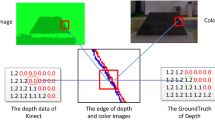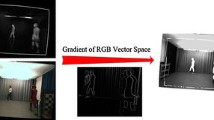Abstract
Image registration, which aim to establish a reliable feature relationship between images, is a critical problem in the field of image processing. In order to enhance the accuracy of color and depth image registration, this paper proposes an novel image registration algorithm based on multi-vector-fields constraints. We first initialize the edge information features of color and depth images, and establish putative correspondences based on edge information. Consider the correlation between the images, establish the functional relationships of the multi-vector-fields constraints based on the relationships. In the reproducing nuclear Hilbert space (RKHS), this constraint is added to the probability model, and the model parameters are optimized using the EM algorithm. Finally, the probability of corresponding edge points of the image is obtained. In order to further improve registration accuracy, this paper will change the input from one pair to two pairs and let the feature transformation relationship between images be iteratively evaluated using the parameter model. Taking publicly available RGB-D images as experimental subjects, results show that for single object image registration, the algorithm image registration accuracy in this paper is improved by about 5% compared with SC, ICP, and CPD algorithms. In addition, artificial noise was used to test the proposed algorithm’s anti-noise ability, results show that the proposed algorithm has superior anti-noise ability relative to SC, ICP and CPD algorithms.




Similar content being viewed by others
References
Belongie S, Malik J, Puzicha J (2002) Shape matching and object recognition using shape contexts. PAMI 24(24):509–522
Chum O, Matas J (2005) Matching with PROSAC – progressive sample consensus. Proc IEEE Conf Comput Vis Pattern Recog 1:220–226
Essmaeel K, Gallo L, Damiani E, Pietro G, Dipanda A (2015) Comparison of methods for filtering for kinect depth data. Multimed Tools Appl 74(17):7331–7354
Fischler MA, Bolles RC (1981) Random sample consensus: a paradigm for model fitting with application to image analysis and automated cartography. Commun ACM 24(6):381–395
Hill DL, Batchelor PG, Holden M, Hawkes DJ (2001) Medical image registration. Phys Med Biol 46(3):R1–45
Jackson BP, Goshtasby AA (2010) Registering aerial video images using the projective constraint [J]. IEEE Trans Image Process 19(3):795–804
Jean-Louis F, Van DDA (2000) The PX-EM algorithm for fast stable fitting of Henderson’s mixed model[J]. Gen Select Evol 32(2):143–163
Jing P, Su Y, Nie L, et al (2018) A framework of joint low-rank and sparse regression for image memorability prediction[J]. IEEE Trans Circ Syst Vid Technol PP (99):1–1
Jing P, Su Y, Nie L, et al (2018) Low-rank multi-view embedding learning for micro-video popularity prediction[J]. IEEE Trans Knowl Data Eng PP(99):1519–1532
Jorge-Peas A, Bov H, Sanen K et al (2017) 3D full-field quantification of cell-induced large deformations in fibrillar biomaterials by combining non-rigid image registration with label-free second harmonic generation[J]. Biomaterials 136:86–97
Lowe DG (2004) Distinctive image features from scale invariant keypoints[J]. Int J Comput Vis 60(2):91–110
Ma J, Zhao J, Tian J, et al (2013) Regularized vector field learning with sparse approximation for mismatch removal. Pattern Recognit 46(12):3519–3532
Ma J, Zhao J, Tian J, Yuille AL, Tu Z (2014) Robust point matching via vector field consensus. IEEE Trans Image Process 23(4):1706–1721
Ma J, Zhao J, Ma Y, Tian J (2015) Non-rigid visible and infrared face registration via regularized Gaussian fields criterion. Pattern Recogn 48(3):772–784
Ma J, Qiu W, Zhao J, et al (2015) Robust L2E estimation of transformation for non-rigid registration. IEEE Trans Signal Process 63(5):1115–1129
Ma J, Zhou H, Zhao J, et al (2015) Robust feature matching for remote sensing image registration via locally linear transforming[J]. IEEE Trans Geosci Remote Sens 53(12):6469–6481
Ma J, Zhao J, Yuille AL (2016) Non-rigid point set registration by preserving global and local structures. IEEE Trans Image Process 25(1):53–64
Ma J, Chen C, Li C, et al (2016) Infrared and visible image fusion via gradient transfer and total variation minimization. Inf Fusion 31:100–109
Ma J, Jiang J, Liu C, Li Y (2017) Feature guided Gaussian mixture model with semi-supervised EM and local geometric constraint for retinal image registration. Inf Sci 417:128–142
Ma J, Ma Y, Li C (2019) Infrared and visible image fusion methods and applications: a survey. Inf Fusion 45:153–178
Ma J, Yu W, Liang P, et al (2019) FusionGAN: a generative adversarial network for infrared and visible image fusion. Inf Fusion 48:11–26
Torr PHS, Zisserman A (2000) MLESAC: a new robust estimator with application to estimating image geometry. Comput Vis Image Under-stand 78(1):138–156
Xie L, Shen J, Han J et al (2017) Dynamic multi-view hashing for online image retrieval[C]. In: Twenty-sixth international joint conference on artificial intelligence, pp 3133–3139
Zhou H, Ma J, Yang C, et al (2016) Nonrigid feature matching for remote sensing images via probabilistic inference with global and local regularizations[J]. IEEE Geosc Rem Sens Lett 13(3):374–378
Zhou H, Kuang Y, Yu Z, Ren S, Zhang Y, Lu T, Ma J (2018) Image deformation with vector-field interpolation based on MRLS-TPS. IEEE Access 7(1)
Zhu L, Shen J, Xie L, et al (2017) Unsupervised visual hashing with semantic assistant for content-based image retrieval[J]. IEEE Trans Knowl Data Eng 29(2):472–486
Zitová B, Flusser J (2003) Image registration methods: a survey. Image Vis Comput 21(11):977–1000
Author information
Authors and Affiliations
Corresponding author
Additional information
Publisher’s note
Springer Nature remains neutral with regard to jurisdictional claims in published maps and institutional affiliations.
This work was supported in part by the National Natural Science Foundation of China under Grants 41501505 and 61771353, Natural Science Foundation of China Open University (G16F2505Q, G16F3702Z), 13th Five Year National Key R&D Project in China “The Hybrid Cloud-based Ubiquitous Location Awareness and Information Overlay Protoco” 2017YFB0503701, the Open Fund of the Key Laboratory of Intelligent Robotics of Hubei Province (HBIR201601) and Research Center of Artificial Intelligence, Yunnan Open University(No.2018JS373) Scientific Research Project of Education Department of Hubei Province(No. 20181508).
Appendix
Appendix
1.1 A.1 Theoretical explanation of convergence
I have consulted a lot of relevant data, trying to prove that the algorithm is convergent theoretically. After many attempts, I realized that the core of the problem is to prove whether the objective function is a convex function.The main functions of the support computation model are:
Where f denotes the mapping relationship between four images, Q (f) denotes the parametric model about f, pn denotes the posterior probability of the mixed model of the n th pair of registration points, and ∥yn − M(xn)∥2 denotes the difference between the n th pair of initial input and the n th pair of target points after transformation,σ represents the standard deviation of Gauss probability model and belongs to the parameter. 〈fk, fk+ 2〉 is the inner product of functions in RHKS space. (that is the formula 10). If we can prove that the\(- \frac {1}{{2{\sigma ^{2}}}} \sum \limits _{n = 1}^{N} {p_{n}}{\left \| {{y_{n}} - M({x_{n}})} \right \|^{2}} \) is convex, then we can solve the problem of convergence proof along the way of EM convergence proof.At the same time, because 〈fk, fk+ 2〉, under the conditions of this paper, can be converted to Gaussian radial basis function values, and negative exponential radial basis function in the independent variable greater than zero, the value of the function tends to zero.
Therefore, the key point is to prove that pn∥yn − M(xn)∥2 is a concave function (When multiplied by \(- \frac {1}{{2{\sigma ^{2}}}}\), it becomes a convex function).Here is our proof:
First, for the polynomial \({\sum }_{n = 1}^{\infty }p_{n}\left \Vert Y_{n}-M(x_{n})\right \Vert ^{2}\), it can be regarded as an infinite series, where 0 <= pn <= 1, 0 <= ∥Yn − M(xn)∥2 <= distmax, (distmax represents the maximum distance between two points in the picture). Further, the inequality can be obtained:0 <= pn ∥Yn − M(xn)∥2N0 <= distmaxN0 < L < 1,N0 is a positive integer greater than zero, L is a constant satisfying the inequality. Obviously, N0 exists.According to the root discriminant method, we know that series \({\sum }_{n = 1}^{\infty }p_{n}\left \Vert Y_{n}-M(x_{n})\right \Vert ^{2}\) must converge. Then, according to the Lazystatistician rule, we get the equation:
where E represents expectation.
In functional analysis, for discrete variables, the two norm of a matrix is equal to the sum of the transformation of functions, that is: \(\left \Vert Y_{n}-M(x_{n})\right \Vert ^{2}\Rightarrow \sum \limits _{n = 1}^{N}D(x_{n})^{2}\),where D(x(n)) is a function equivalent expression of ∥Yn − M(xn)∥2.
After that ,according to Hilbert kernel space property, any function in space can be represented by a base, \(D(x_{n})={\sum }_{i = 1}^{N}D_{i}\sqrt {\lambda _{i}}\psi _{i},D_{i}\),where D(xn) is the transformation of the i th component, λi is the corresponding constant of the i th transformation, and ψi is the kernel function. And the kernel function in this paper is ψi = exp(−β ∥x − xi∥2), (β > 0),it’s a concave function,and because concave function adds or concave function, so the D(xn) is a concave function, plus the minus sign of \(- \frac {1}{{2{\sigma ^{2}}}}\), \(- \frac {1}{{2{\sigma ^{2}}}} \sum \limits _{n = 1}^{N} {p_{n}}{\left \| {{y_{n}} - M({x_{n}})} \right \|^{2}} \) has the function property of convex function.
According to Jensen inequality, E(D(xn)) >= D(E(xn)),if and only if x1 = x2 = x3 = ... = xn obtains an equal sign. Therefore,
\(-\sum \limits _{n = 1}^{N} {p_{n}}{\left \| {{y_{n}} - M({x_{n}})} \right \|^{2}}>=\sum \limits _{n = 1}^{N}p_{n}Y_{n}+\sum \limits _{n = 1}^{N}p_{n}M(x_{n})\).In the M-step of EM algorithm, the parameter maximization ensures that the lower bound \(\sum \limits _{n = 1}^{N}p_{n}Y_{n}+\sum \limits _{n = 1}^{N}p_{n}M(x_{n})\) is greater than or equal to that before the iteration, so we can gradually approximate the convergence value of the objective function by raising the lower bound \(\sum \limits _{n = 1}^{N}p_{n}Y_{n}+\sum \limits _{n = 1}^{N}p_{n}M(x_{n})\) iteratively.
Therefore, the objective function is convergent in theory.
1.2 A.2 Notation table
Table 3 is a supplement to the symbols of the formula, including the collection of main symbols.
Rights and permissions
About this article
Cite this article
Li, X., Li, D., Peng, L. et al. Color and depth image registration algorithm based on multi-vector-fields constraints. Multimed Tools Appl 78, 24301–24319 (2019). https://doi.org/10.1007/s11042-018-7048-4
Received:
Revised:
Accepted:
Published:
Issue Date:
DOI: https://doi.org/10.1007/s11042-018-7048-4




